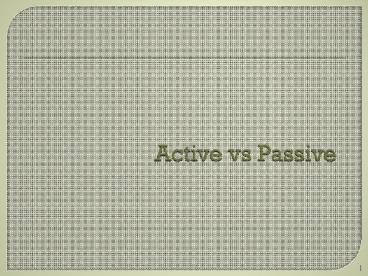Active vs Passive - PowerPoint PPT Presentation
1 / 16
Title:
Active vs Passive
Description:
Title: Evaluating Portfolio Performance Author: Sheri Theresa Tice Created Date: 4/15/1999 3:41:03 AM Document presentation format: On-screen Show (4:3) – PowerPoint PPT presentation
Number of Views:243
Avg rating:3.0/5.0
Title: Active vs Passive
1
Active vs Passive
2
ACTIVE EQUITY MANAGEMENT
- Goal Earn a portfolio return net of
transaction costs and expenses that exceeds the
return of a passive benchmark portfolio (most
often an index) on a risk-adjusted basis.
3
Challenges (Active)
- 1. Costs Fees
- Transaction Costs and fees range from 1 - 2
of assets under management on average. (hurdle)
4
Challenges (Active)
- 2. Appropriate Evaluation of Performance
- Difficulty differentiating Luck from Skill
- Appropriate Risk-Adjustment Model?
- (CAPM vs Fama-French Factor Model vs
- Other Models)
5
Themes of Active Mgmt
- Asset Allocation
- Stocks, Bonds, Money Market
- Sector Allocation
- Overweighting and underweighting based on
industry, size, or value vs. growth - Individual Stock Selection
6
Backtesting
- Test to see if trading rules would have worked
using historical data. - Subject to data mining criticisms as you can
always find some patterns. It does not mean that
they will persist in the future.
7
Terminology
- Quadratic Programming Efficient frontier
optimization in Mean/Variance Space based on
Expected Returns, Standard Deviations, and
Correlations
8
Passive Equity Management
- Logic Market is fairly efficient. Too difficult
to overcome 1 - 2 costs of running an active
equity portfolio. - Dont try to beat the market, just equal it and
keep expenses to a bare minimum.
9
Passive Features
- Portfolio is built without using technical or
fundamental analysis. - Buy Hold The securities are purchased and then
held with only occasional re-balancing (reinvest
dividends, a change in the index etc..)
10
Index Funds
- Passive portfolios that track an index and sell
shares to investors are called Index Funds. - (Ex Vanguard 500 Index which tracks the SP
500.)
11
Index Funds
- Manager Performance Judged by how well he/she
tracks the index and by the costs generated to
do so.
12
Index Fund Types
- 1. Full Replication Buy all stocks in the index
in proportion to their weights in the index.
13
Index Fund Types
- 2. Sampling Buy the stocks with larger index
weights hold a representative sample of the
others. - Benefit Relative Full Replication Lower
commissions (less stocks to purchase and to
reinvest dividends). - Drawback Relative Full Replication Will be
Tracking Error
14
Evaluating Index Fund Manager Performance
- R-Squared Measures how closely the fund is
moving with the benchmark index. - This measures tracking, but not costs!
15
Exchange Traded Funds
- An alternative to buying shares in an Index Fund.
- Depositary receipts with underlying stocks in an
index held in deposit by the financial
institution that issued certificates. - Shares are traded like a stock but represent a
claim on the portfolio.
16
Exchange Traded Funds
- Example SPDRs Depositary receipts on the SP
500. - Buy like a share of stock no fund marketing fees
(means lower expenses). - No cash on hand to handle fund flows.
- Trade when market open not just at market close
price. - Can be shorted or purchased with margin.
- Some new ETFs are actively managed































